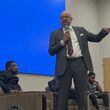‘A DEAFENING SILENCE’
Atlanta Symphony Orchestra musicians and their supporters are planning to gather across Peachtree Street from the Woodruff Arts Center at 7:10 p.m. Thursday, on what was to be the season-opening night, for an observance that borrows its title from Robert Spano’s newspaper quote: “A Deafening Silence.”
Atlanta Symphony Orchestra Music Director Robert Spano has sounded his strongest notes yet about the ASO’s contract crisis after management’s Monday announcement that it was canceling the first part of the orchestra’s 70th anniversary season.
“This is a dire and critical juncture for the city of Atlanta, which is in danger of losing the flagship of its culture,” Spano said in Wednesday’s editions of The New York Times. “If the 10th-largest urban economy in America is incapable of sustaining its cultural jewel, what does that signal about our country?”
He also dismissed a management proposal giving it ultimate power to reduce the size of the orchestra, which was cut from 95 to 88 musicians in contentious 2012 collective bargaining agreement negotiations in which the players took a 14 percent pay cut.
Spano said any further reduction would require the ASO to lean harder on part-time players at the expense of its sound. “No aspersion to their gifts,” the music director said in the Times story, “but that means that the orchestra’s quality suffers.”
He also said that the ASO demands a healthy “complement” of full-time members not only for the music but for health, workload and community engagement reasons.
“Would you want the Falcons playing with one quarterback?” he asked.
Officials with the ASO and its parent nonprofit the Woodruff Arts Center acknowledged Wednesday that they were caught off guard by Spano’s public stand.
“We are not surprised at Robert’s passion, but we are surprised that he has broken with industry tradition by talking to the media,” ASO spokeswoman Holly Hanchey said. “We are hopeful everyone will concentrate on what’s most important: finding long-term solutions that will allow us to balance the (orchestra’s) artistic and financial needs.”
Spano and ASO principal guest conductor Donald Runnicles penned a carefully worded letter to the musicians and ASO and Woodruff leaders in early September, just before management locked out the musicians for the second time in two years. Though they asserted then that they didn’t want to take sides, the maestros asked management to “acknowledge the sacrifice the musicians have already made.”
Published comments in recent days by Spano and Runnicles find them being far more direct.
In the U.K. newspaper the Guardian, Runnicles termed the lockout “a one-sided attempt to force the orchestra to its collective knees.”
Spano lamented to the Times that “our brilliant and creative musicians, who need to be intimately involved in the creation of our path to the future, have been asked to leave the building — and Atlanta is left with a deafening silence.”
The boldness of the comments is striking given that musical leaders are typically neutral parties in orchestra labor disputes. Spano and Runnicles are neither management nor part of the Atlanta Symphony Musicians Players’ Association.
But as the lockout moves through its third week, it’s becoming loud and clear that the disagreement isn’t merely over pay and benefits but the future of the ASO.
Management’s final offer before the lockout was for a four-year deal with a modest raise that Players’ Association leaders said would be negated by health coverage cost increases. Who controls the size of the orchestra, however, may prove a thornier issue.
ASO president and CEO Stanley Romanstein wants final say on filling openings, after consultation with Spano and Players’ Association representatives. The players say they don’t trust him with that power.
A recent public letter of support for the locked-out musicians from members of the Atlanta Symphony Orchestra Chorus revealed that Spano’s backing extends beyond his words. It noted that he had helped fund last May’s Carnegie Hall appearance by the ASO and chorus — to the tune of $50,000 — to keep the tour from being canceled.
The ASO has racked up deficits for 12 consecutive years, but the push toward what management has termed a “sustainable model” took new urgency when the accumulated debt rose to $23 million by the end of fiscal 2012, including $18 million borrowed against earnings on the orchestra’s endowment.
In 2013, Moody’s Investors Service downgraded the Woodruff Art Center’s credit outlook from stable to negative, largely because of the ASO debt. Woodruff president and CEO Virginia Hepner noted that that harms the art center’s ability to attract project financing, raises interest costs and could affect operations of its other divisions, including the Alliance Theatre and High Museum of Art.
The orchestra finished the 2014 fiscal year with a $2 million operating deficit on a budget of $37 million.
Management said the musicians’ final contract proposal would add another $2 million in red ink and would signal to the foundation community “that we are not committed to finding a long-term solution,” spokeswoman Hanchey said.
The ASO and Woodruff chose a lockout instead of the “play and talk” scenario sought by the musicians, she said, because the latter would cost the ASO between $25,000 and $30,000 per day in compensation without promise of a resolution. Management said it instead has proposed bringing in federal mediator Allison Beck, who was involved in the Metropolitan Opera’s recent contract ratification.





